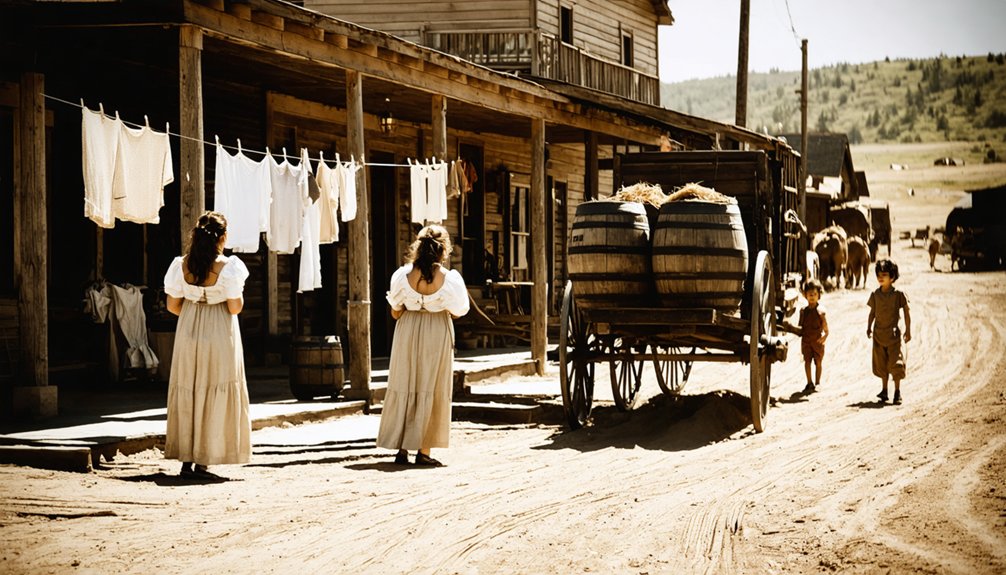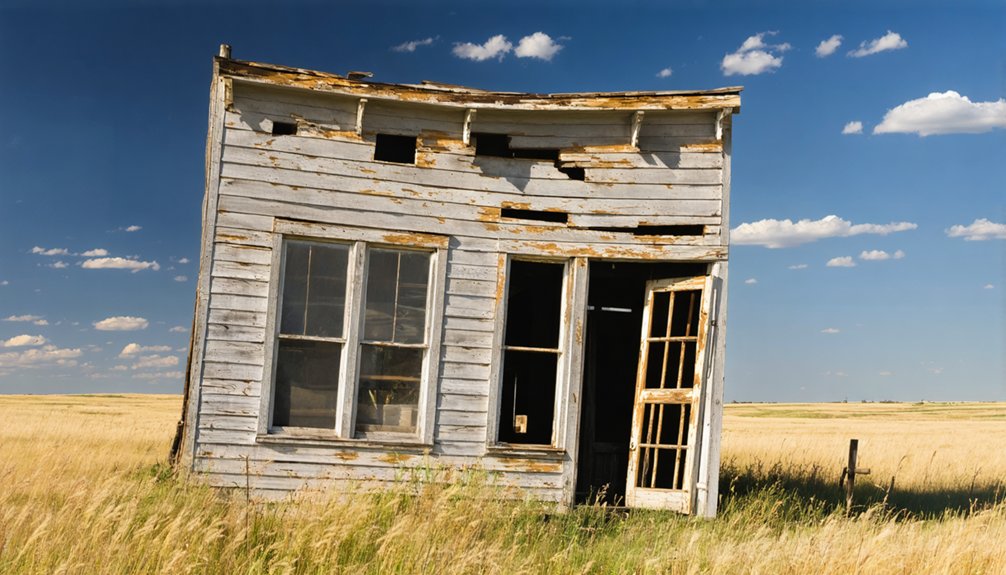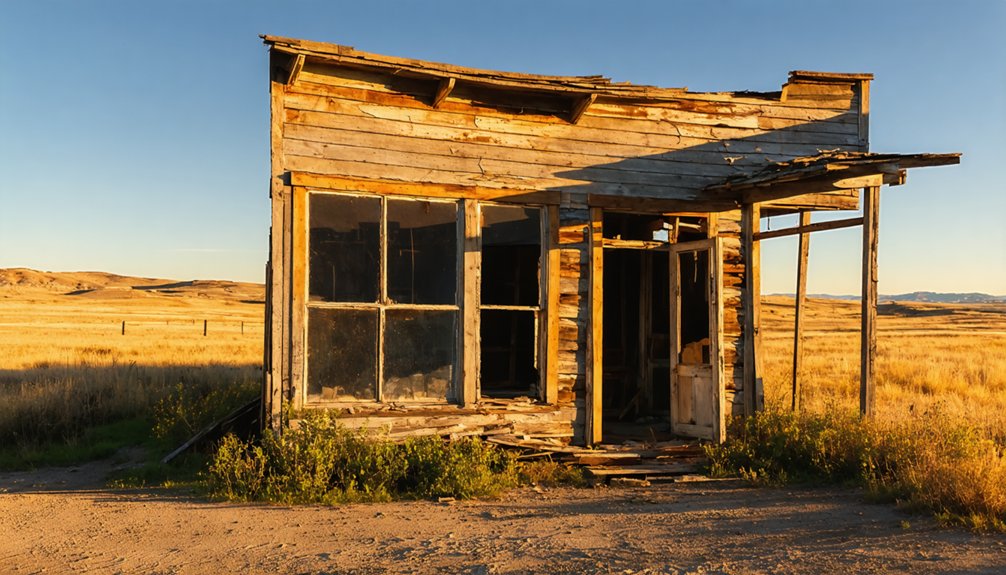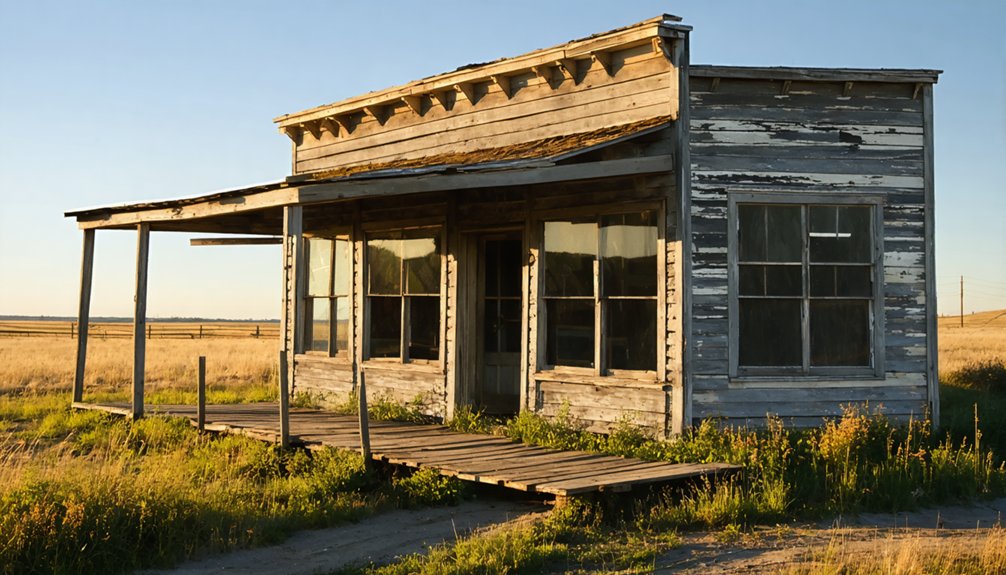You’ll find Blacktail nestled in South Dakota’s Black Hills, where it emerged during the 1870s gold rush alongside the famous Homestake Mine. This mining settlement thrived as thousands of prospectors defied the Treaty of Fort Laramie in search of fortune. Daily life centered around mining operations, with families living in rough-hewn cabins while men worked dangerous shifts. Today, its weathered stone foundations and crumbling walls tell a deeper story of boom, bust, and frontier ambition.
Key Takeaways
- Blacktail emerged during the Black Hills Gold Rush, growing rapidly after 1874 due to gold discoveries and the establishment of mining operations.
- The town’s economy centered around the Homestake Mine, which produced over 40 million troy ounces of gold throughout its operation.
- Daily life featured miners living in rough-hewn shacks, working dangerous shifts while families supported the community through various roles.
- The depletion of mineral deposits and harsh winters led to Blacktail’s abandonment, as mining jobs disappeared and families relocated.
- Today, Blacktail exists as a ghost town with crumbling stone foundations and weathered walls, attracting history enthusiasts and photographers.
Origins of a Mining Settlement
Like many settlements that emerged during the Black Hills Gold Rush, Blacktail’s story began in the wake of Colonel George Custer’s 1874 expedition that confirmed the presence of gold in the region.
You’ll find that early prospectors flocked to the area, following rumors that dated back to the early 1800s when Native Americans were first seen carrying gold from these hills.
As gold discovery techniques evolved from simple placer mining in streambeds to more sophisticated methods, settlements like Blacktail sprung up virtually overnight.
Despite existing treaties with the Sioux, thousands of miners pushed into the territory, driven by the promise of striking it rich.
Initially, these mining camps started with basic infrastructure – just enough to support the determined prospectors searching for loose gold nuggets and flakes that would signal larger deposits in the surrounding rock.
Miners utilized hydraulic mining techniques extensively, particularly in nearby areas like Rockerville in their relentless pursuit of gold deposits.
The influx of miners violated the Treaty of Fort Laramie and led to increasing tensions with local tribes.
Life During the Gold Rush Era
You’d find Blacktail’s mining families living in rough-hewn shacks and tents, where men worked punishing shifts at the mines while women managed households under primitive conditions.
The 1868 Fort Laramie Treaty had originally protected this land for Native American tribes before the rush of miners arrived. The social structure revolved around the Homestake Mine’s operations, with wealthy mine owners and investors at the top, while most miners scraped by on meager wages despite the region’s immense gold production. The mine’s staggering output of 40 million ounces of gold primarily benefited a small group of investors rather than the workers.
In the male-dominated boomtown environment, residents gathered at saloons and gambling halls for entertainment, though the few families present attempted to establish more conventional community institutions.
Mining Family Daily Life
While gold fever drew countless prospectors to the Black Hills, the daily routines of mining families in Blacktail revolved around dawn-to-dusk labor and survival. The discovery of significant placer gold in late 1875 brought even more families seeking fortune to the area.
Family roles were strictly divided, with men heading into hazardous mine shafts while women managed households and children tackled smaller daily chores. Like their neighbors in Deadwood’s gold rush, which drew between 5,100 to 10,000 people in the summer of 1876, mining settlements quickly grew into bustling communities.
You’d find these hardy families living in hastily built log cabins or wooden shanties, cooking over wood stoves and hauling water from nearby streams.
- Your breakfast might’ve been hardtack and salted pork before heading to the mines
- You’d spend hours repairing equipment and hauling ore in hopes of striking it rich
- Your wife would preserve food through smoking and pickling to stretch supplies
- Your children would help by fetching water and tending to livestock
Rush Town Social Structure
Beyond the private sphere of mining families, Blacktail’s social structure reflected the raw, untamed nature of rush towns across the Black Hills.
You’d find a fluid social hierarchy where wealth and personal power, not traditional status, determined your standing. At the top, successful mine owners and shrewd entrepreneurs controlled the town’s economic destiny, while most miners struggled daily for their share of gold.
In this male-dominated community, you’d encounter a diverse mix of fortune seekers, from immigrant miners to professional gamblers. The rush for riches intensified after Deadwood Gulch deposits were discovered in late 1875.
Community dynamics centered around the saloons and informal gathering spots where deals were made and disputes settled. Without formal courts, you’d rely on miners’ courts for justice, while armed self-protection became a necessity in a place where claim jumping and theft remained constant threats.
The Homestake Mine Connection
You’ll find Blacktail’s story inextricably linked to the Homestake Mine’s success, as its strategically positioned mills at the confluence of Blacktail and Bobtail Gulches processed ore from the region’s largest gold mining operation.
The mining camp’s mill operations expanded alongside Homestake’s incredible growth, which saw the workforce swell to 500 employees by 1879 while milling capacity increased twenty-fold from 10 to 200 stamps. During its peak years, the mine produced an astounding 40 million ounces of gold. The mine’s early development was shaped by George Hearst and his partners, who acquired the claim in 1877 for $70,000.
Your journey through Blacktail’s remains today reveals traces of a once-bustling community that supported Homestake’s round-the-clock operations until the area’s eventual decline into a ghost town.
Mining Operations and Growth
Although Blacktail’s history is deeply intertwined with the Homestake Mine, the connection began with Moses and Fred Manuel’s significant gold discovery near Deadwood in 1875-1876.
When George Hearst acquired their claim, he transformed the operation into North America’s largest gold producer, with Blacktail serving as a vital milling hub due to its strategic geology at the convergence of Blacktail and Bobtail Gulches. By 1900, the operation had grown to employ over 2000 workers across its extensive mining network.
- You’ll find remnants of Homestake’s ambitious expansion from a 10-stamp mill to 200 stamps
- You can trace the mining logistics that connected Blacktail to the Black Hills & Fort Pierre Railroad
- You’re walking the same ground where 500 workers once processed precious ore
- You’re witnessing the legacy of a 30-acre operation that shaped the Black Hills forever
Mill Development Over Time
While George Hearst’s initial investment in the Homestake claim laid the foundation, it was the construction of an 80-stamp mill in July 1878 that truly launched large-scale gold processing in the Black Hills.
You’ll find that mill technology evolved markedly as mining operations pushed deeper underground, with the facility’s capacity expanding to match the mine’s growing output.
The mill’s strategic location near the vein minimized hauling costs across challenging terrain, while continuous upgrades to ore processing equipment helped achieve unprecedented gold recovery rates.
Throughout the late 19th and early 20th centuries, you’d have witnessed the implementation of advanced crushing, grinding, and chemical extraction methods like cyanidation.
These improvements proved essential in Homestake’s ascent to become North America’s most productive gold mine, eventually yielding over 40 million troy ounces.
Worker Community Life
Since the Homestake Mining Company owned most of the land in Lead, South Dakota, the company exerted unprecedented control over its workers’ daily lives through an intricate system of company-owned housing, stores, and infrastructure.
You’d find miners and their families living within walking distance of the mine, shopping at company stores, and often trapped in cycles of credit between paydays.
Despite these constraints, worker solidarity emerged through:
- Strong union cooperation under Thomas J. Grier’s management
- Community events centered around local churches and schools
- Shared recreational facilities that brought families together
- A unique form of industrial socialism that set Lead apart from other mining towns
You’ll notice how this tight-knit community formed not just through proximity, but through shared experiences of working 8,000 feet underground and facing common challenges in this company-controlled town.
Daily Life in Early Blacktail

As miners flocked to Blacktail in search of gold during the town’s early days, daily life centered around the demanding work at the Homestake Mine and its associated mills.
You’d find yourself rising early for long shifts underground or operating complex milling machinery, facing dangerous conditions to earn your living. After work, you’d return to your simple wooden cabin, where basic amenities were scarce.
Daily routines revolved around survival and camaraderie in this remote setting. You might barter for supplies at the general store or gather with fellow miners at the local saloon.
In Blacktail’s rugged landscape, miners found strength in unity, trading goods and sharing stories after grueling days underground.
Community gatherings, like impromptu dances or celebrations of mining successes, offered brief respites from the harsh realities of frontier life. When supplies ran low, you’d rely on wagon deliveries from nearby Lead for essential goods.
The Path to Abandonment
When Blacktail’s rich mineral deposits began depleting in the late 19th century, the town’s fate quickly spiraled toward abandonment. The community’s economic dependency on mining proved devastating as ore quality diminished and extraction costs soared.
You’ll find that Blacktail’s story mirrors many Black Hills settlements, where isolated locations and harsh winters accelerated their demise.
- Your ancestors watched helplessly as mining jobs vanished, forcing families to seek opportunities elsewhere.
- You can imagine the eerie silence that fell over once-bustling mills near the Homestake Mine.
- You’d notice how the rugged 4,777-foot elevation that once protected valuable minerals now hindered survival.
- Your community would’ve struggled against the brutal reality of having no alternative industries.
The resulting population decline transformed this once-thriving settlement into another Black Hills ghost town, joining countless others claimed by the region’s boom-and-bust cycle.
Architectural Remnants Today

The architectural remnants of Blacktail stand as haunting symbols to the town’s mining era, with crumbling stone foundations and weathered walls scattered across the Black Hills landscape.
Weathered stones and broken walls whisper tales of Blacktail’s mining past across the rugged Black Hills terrain.
You’ll find simple architectural styles typical of late 19th-century mining towns, characterized by utilitarian designs and locally sourced materials. Stone masonry foundations have proven most resilient against time’s passage, while wooden structures have largely succumbed to decay.
Preservation challenges are evident throughout the site, where decades of exposure to harsh weather and neglect have taken their toll.
What’s left are deteriorating chimney stacks, partial vertical walls, and the ghostly outlines of former mining operations.
While you’re free to explore these historic ruins, you’ll need to exercise caution due to unstable structures and hidden mine shafts.
Exploring the Historic Site
Today’s visitors to Blacktail can explore this fascinating ghost town by following several well-worn paths that wind through the remnants of Lawrence County’s mining history.
Located at 4,777 feet elevation near the meeting of Blacktail and Bobtail Gulches, this historical site offers you a unique glimpse into South Dakota’s mining era.
During your ghost town exploration, you’ll discover:
- Weathered ruins that tell stories of the Black Hills gold rush
- Strategic viewpoints where you can spot features of former mining operations
- Historic mill sites that once processed ore from the renowned Homestake Mine
- Original pathways between what were once miners’ homes and work sites
The site’s historical significance makes it a prime destination for photographers and history enthusiasts seeking to document South Dakota’s mining heritage.
Legacy in Black Hills History

Nestled within Lawrence County’s rich mining heritage, Blacktail stands as a tribute to the transformative power of the 1870s Black Hills Gold Rush.
You’ll find this ghost town‘s cultural significance deeply rooted in its role as a vital milling site for the legendary Homestake Mine, where it helped establish the region’s prominence in national and international gold markets.
Today, Blacktail’s remains join over six hundred ghost towns scattered throughout the Black Hills, each telling a unique story of boom-and-bust cycles that shaped South Dakota’s mining era.
Ghost towns like Blacktail echo through the Black Hills, silent witnesses to South Dakota’s golden age of mining prosperity and decline.
The site’s historical preservation efforts maintain its authentic atmosphere, allowing you to experience a tangible connection to the past.
As you explore the ruins, you’ll witness how this once-bustling mill town exemplifies the transient nature of mining communities that defined the American West.
Frequently Asked Questions
Are There Any Documented Paranormal Activities or Ghost Sightings in Blacktail?
You won’t find any verified ghost encounters or paranormal investigations in Blacktail’s records. Unlike other Black Hills ghost towns, there aren’t credible reports of supernatural activity at this former mining camp.
What Wildlife Species Now Inhabit the Abandoned Buildings and Surrounding Area?
Among 20+ documented wildlife sightings, you’ll find bats roosting in abandoned structures, while coyotes, bobcats, and deer frequent the area. Eagles soar overhead and songbirds nest in deteriorating buildings.
Was There Ever a Cemetery Established in Blacktail During Its Operation?
You’ll find no definitive cemetery records from Blacktail’s operational years, though typical mining camp burial practices suggest informal gravesites may have existed in the surrounding gulches and hillsides.
Did Any Famous Outlaws or Notable Historical Figures Visit Blacktail?
Truth is stranger than fiction, but you won’t find any evidence of notable visitors or outlaw legends in the historical records – no famous outlaws or Wild West figures visited this mining camp.
What Native American Tribes Originally Inhabited the Land Where Blacktail Was Built?
You’ll find that the Lakota Sioux dominated the area when Blacktail was built, though they’d previously displaced the Cheyenne tribe and others who had inhabited these sacred Black Hills lands.
References
- https://www.powderhouselodge.com/black-hills-attractions/fun-attractions/ghost-towns-of-western-south-dakota/
- https://www.youtube.com/watch?v=Glucs_Rq8Xs
- https://www.wikiwand.com/en/articles/Blacktail
- https://www.sdpb.org/rural-life-and-history/2023-08-21/some-black-hills-ghost-towns-and-their-origins
- https://www.blackhillsbadlands.com/blog/post/old-west-legends-mines-ghost-towns-route-reimagined/
- https://kids.kiddle.co/Blacktail
- https://www.sdhspress.com/journal/south-dakota-history-2-2/some-black-hills-ghost-towns-and-their-origins/vol-02-no-2-some-black-hills-ghost-towns-and-their-origins.pdf
- https://www.youtube.com/watch?v=_0WNYsFLSLA
- https://en.wikipedia.org/wiki/List_of_ghost_towns_in_South_Dakota
- https://www.americanhistorycentral.com/entries/black-hills-gold-rush/



